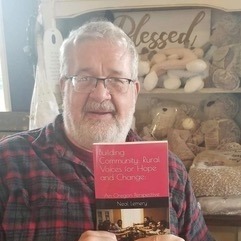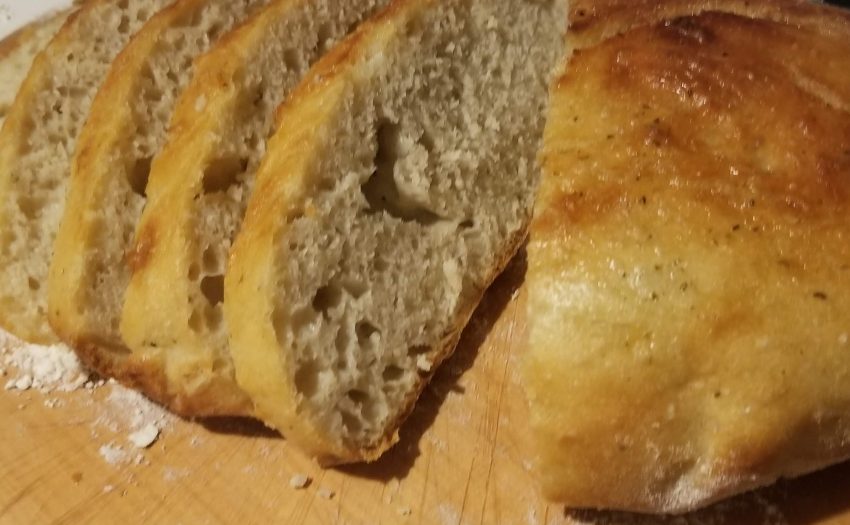
By Neal Lemery
It was time to get back to something basic, something that I could feel, touch, connect with on a gut level. Remembering the good times as a kid, with family in the kitchen, making something, cooking, being able to nourish the family and my soul. Remembering the good conversations, the laughter, the smells of baking, the satisfaction of making “homemade”.
Homemade. A word that is now scarce, yet evokes purpose and contentment. Accomplishment. And satisfaction.
I’ve always been a bread maker, and returned to that during the Pandemic, as something meaningful, giving me a sense of accomplishment. My starter had long expired, and so I started anew. Directions told me to mix flour and water, and let it sit on the kitchen counter, partially covered, and to add a little flour and water every day. Within a few days, it became alive, with bubbles, and a new texture. It started to smell yeasty, literally taking on a life of its own. Day by day, the mixture became more active, more aromatic, literally coming alive from the air, and the simplicity of flour and water. I had added some dark rye flour, the directions saying that adding a few trace minerals and more complexity in the yeast would make a better starter. So it is true in life, add a few trace elements, something unusual, and let things thrive.
All too soon, it was time to actually make bread, and so I began with a cup of the starter, now nice and bubbly, aromatic, somewhat elastic, definitely a living thing. The recipe was simply the starter, some salt, more flour and water, a scant tablespoon of sugar. I began to stir, and then, in adding more flour, it became more solid than liquid. I gave homage to the yeast, this thing that literally came out of thin air, and began to grow, even thrive. It was a lifespring, calling me out to connect, celebrate.
Gluten formed, out of my stirring with a spoon and then kneading the mass with my hands, my fingers now half dough, half flesh. My work seemed the work of a wizard, a magician, bringing something to life. The gooey mixture stuck to my hands, and with more flour, turned into a wet dough, and then a drier dough, growing into a loaf. More gluten formed, more solidification occurred, until the ball resisted me, pushed back, becoming more elastic, pliable, even dense. When more flour wasn’t being absorbed, I gave the ball a final kneading and shaping, and let it rest in its bowl. This bread, this loaf, knew what it needed. I just needed to be quiet, to listen, to learn.
Much of sourdough baking is having patience, of waiting, letting things happen on their own schedule. It is a great lesson to learn, to wait and let things develop in their own good time, and to simply take a breath and let things happen on Sourdough Time. I can sometimes be the facilitator, adding flour, kneading, and watching. I needed to sense what is needed and then supplying those necessities sparingly, with observation and some thought. And, experience.
The dough is dynamic, alive. Part of my job, perhaps the most important, is to simply watch, observe, to feel, touch, be present, and then to respond as needed. It is not a rush job, something that requires a sense of urgency, speed. In fact, I do better if I contemplate a response, yet wait and wonder whether or not my action plan is really what is needed. This work is a meditation in patience. Wait and contemplate whether or not my action plan is really what is needed.
It was classroom time, and the teacher was not me, but a glob of water and flour over six days on the kitchen counter. I just needed to show up and pay attention, and to do what works at any given time.
It was a time of reunion, of reconnecting with my grandmother and my mother, of the times we baked together. I again heard their laughter, their stories told when they mixed the flour and the water and the salt, and shaped the growing mounds of dough into loaves, into family meals around the table, where more stories were told, and memories made. The dusting of flour on my face and on my shirt stirred memories of olden times, rich stories and family news.
An hour and a half later, I kneaded more, adding a little flour, compressing it and feeling it spring back a little, resisting me. Give and take. And learn. Breadmaking is a school, a class, an experiment in hands-on learning, and a work of art. The flour, water, salt, sugar, the mixing, stirring, kneading are all part of the lesson plan, the experience. The lessons to be learned were abundant, compelling.
I placed the loaf, which is what it has become, in another bowl, with ridges and patterns, giving it a shape so that when it comes out of the oven, it is decorated with patterns, more of a work of art.
Again, I gave it more time, more resting, more being patient and waiting. I had some other chores, and wasn’t much of a clock watcher, each loaf in its own good time. About two hours later, I turned on the oven: 400 degrees. I’ve learned that a fully heated oven needs to sit for at least fifteen minutes longer after the buzzer goes off, so that the oven is fully heated. The right time to bake is intuitive, not mechanical. It’s another lesson in patience, in trusting your gut.
The rack was right in the center, and I eased the loaf out, now turned upside down so that the pattern from the new bowl was fully pressed into the loaf. It was a lesson in that we are all here as the product of others, shaped by others, formed and molded, and that we grow from that, we emerge from the forms of others.
I put it on a cookie sheet, with a scattering of cornmeal, and slid it into the hot oven for 40 minutes. And I waited.
Knowing that baking time is an individualistic idea, I kept an eye out for the last ten minutes, adjusting baking time accordingly. Again, I gave the process patience, observing, and trusting my gut. I was respecting that this loaf, this bread baking, is an art form, that my work is bringing something into life, and letting it flourish, comes into its own. I can be a part of that creation, yet the dynamic of change and growth is in and of itself, its own existence. I can be a nurturer, a bringing together of the elements. Yet, the creating, the growth, becoming its own, is not mine. I am not the creator; I am the facilitator, the convenor.
At last, the loaf was a dark, golden brown mound of deliciousness, its smell filling the house with toasty, earthy smells, and memories of other bread makings.
Six days, from the start of a wet mixture of flour and water, turning into a piping hot loaf of caramel crunchy crust and soft dense yet fluffy bread, it was in need of some slicing and butter. It joined that night’s lasagna, a dense, hearty slice matching well with the homemade pasta, tomato sauce, spinach, and slices of zucchini. It was a simple meal, basic. And, it was so nurturing, and so worth waiting for.

Books: NEW book – Building Community: Rural Voices for Hope and Change; Finding My Muse on Main Street, Homegrown Tomatoes, and Mentoring Boys to Men


